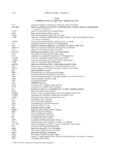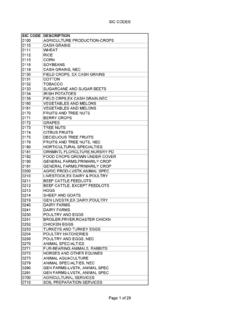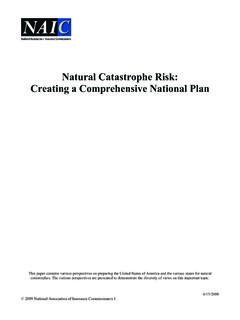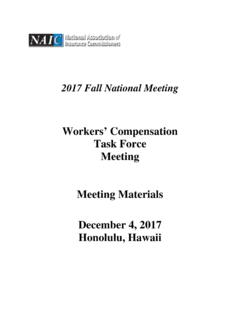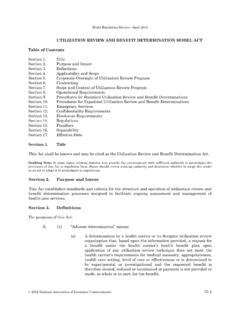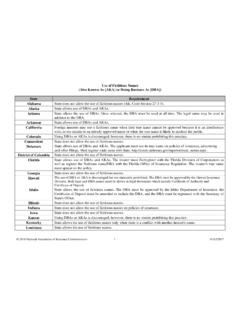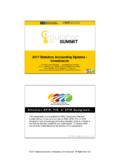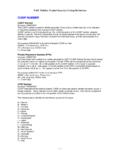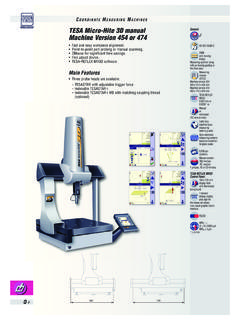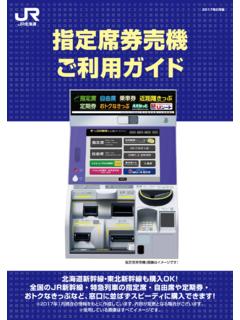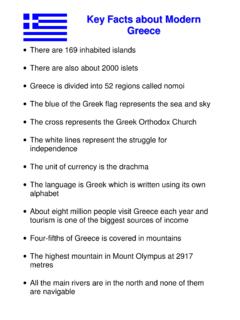Transcription of Casualty Actuarial and Statistical (C ) Task Force Price ...
1 Nov. 19, 2015 1 Casualty Actuarial and Statistical (C) Task Force Price Optimization White Paper I. Scope 1. In this paper, the Casualty Actuarial and Statistical (C) Task Force provides background research on Price optimization, identifies potential benefits and drawbacks to the use of Price optimization, and presents options for state regulatory responses regarding the use of Price optimization in ratemaking. The Task Force is not expressing an opinion on the policy decisions that have been or may be made by each state concerning rating practices that may incorporate Price optimization. 2. The primary focus of the paper is on personal lines ratemaking. Ratemaking concepts and principles ( , cost-based Actuarial indications or unfair discrimination) may have application to commercial lines of business, as well.
2 3. Though Price optimization could be used in risk selection, marketing or other insurer operations, these issues are not addressed in this paper. The NAIC should consider whether these are issues that need to be addressed. II. Introduction 4. Ratemaking is the process of establishing rates used in insurance or other risk transfer mechanisms. This process may involve a number of considerations, including estimates of future claims costs and expenses, profit and contingencies, marketing goals, competition, and legal restrictions. Actuaries play a key role in the ratemaking process and are generally responsible for determining the estimated costs of risk transfer. The advent of more sophisticated data mining tools and modeling techniques have allowed the use of more objective and detailed quantitative information for aspects of the rate-setting process for which insurers have traditionally relied on judgment or anecdotal evidence.
3 5. Making adjustments to actuarially indicated rates is not a new concept; it has often been described as judgment. Insurers often considered how close they could get to the indicated need for premium without negatively affecting policyholder retention and how a given rate would affect the insurer s premium volume and expense ratio. Before the introduction of data-driven quantitative techniques, the answers to these questions were largely subjective. Historically, when judgment was applied, the changes were made on a broad level ( , an entire rating territory). 6. In recent years, through a process or technique referred to by many as Price optimization, insurers have started using big data (data mining of insurance and non-insurance databases of personal consumer information where permitted by law), advanced Statistical modeling or both to select prices that differ from indicated rates at a very detailed or granular level.
4 Formalized and Nov. 19, 2015 2 mechanized adjustments can be made to indicated rates for many risk classifications and, ultimately, perhaps even for individual insureds. 7. According to the Casualty Actuarial Society (CAS), until recently, companies had limited ability to quantitatively reflect individual consumer demand in By measuring and using Price elasticity of demand, an insurer can optimize prices to charge the greatest Price without causing the consumer to switch to another insurer. It is this use of elasticity of demand that has led to criticisms that Price optimization penalizes customers. 8. Critics object to insurers use of Price optimization when it results in unfairly discriminatory rates. Price optimization may use external, non-insurance databases to gather personal consumer information or detailed information about competitors pricing to model consumer demand and predict the response of consumers to Price changes.
5 Some critics argue that Price optimization has been developed to increase insurers profits by raising premiums on individuals who are less likely to shop around for a better Price , and many of these people are low-income consumers. The Consumer Federation of America (CFA) asserts that Price optimization introduces a systematic component to rate setting unrelated to expected losses or expenses. The CFA has called Price optimization unfairly discriminatory, claiming that it can result in drivers with the same risk profile being charged different 9. Regulators accept some deviations from indicated rates and rating factors. However, they are concerned that the use of sophisticated methods of Price optimization could deviate from traditional ratemaking, extending beyond acceptable levels of adjustment to cost-based rates and resulting in prices that vary unfairly by policyholder.
6 Regulators in each state determine the acceptable level of adjustment allowable based on state law and regulatory judgment. 10. In late 2013, the NAIC s Auto Insurance (C/D) Study Group began to study the use of Price optimization in auto insurance. Because the topic of Price optimization goes beyond auto insurance and requires a great deal of Actuarial or Statistical expertise, the Study Group asked the Task Force to perform any additional research necessary on the use of Price optimization, including studying regulatory implications, and respond to the Study Group with a report or white paper documenting the relevant issues. III. Background: State Rating Law, Actuarial Principles and Definitions 11. The basis for all rate regulation is established by the state law both statutory and case law.
7 State authority is derived from the inclusion in almost all states laws that personal lines insurance rates 1. Casualty Actuarial Society Committee on Ratemaking Price Optimization Working Party 2. Consumer Federation of America, March 31, 2014. Insurance Commissioners Should Bar Industry Practice of Raising Rates on Customers Based on Shopping Habits, accessed at Nov. 19, 2015 3 shall not be inadequate, excessive or unfairly discriminatory. 3 The NAIC has three model law guidelines related to rate regulation: 1) Property and Casualty Model Rating Law (File and Use Version) (#1775);4 2) Property and Casualty Model Rate and Policy Form Law Guideline (#1776);5 and 3) Property and Casualty Model Rating Law (Prior Approval Version) (#1780).
8 6 12. In Model #1775 and Model #1776, the description of unfairly discriminatory rates is as follows: Section 5. Rate Standards Rates shall be made in accordance with the following provisions: A. Rates shall not be excessive, inadequate, or unfairly discriminatory.. (3) Unfairly Discriminatory Rates. Unfair discrimination exists if, after allowing for practical limitations, Price differentials fail to reflect equitably the differences in expected losses and expenses.. 7 In Model #1780,8 a description of unfairly discriminatory rates is suggested to be adopted in regulation but does not provide wording for the description. 13. The Actuarial profession utilizes ratemaking principles. The following are the four principles in the CAS Statement of Principles Regarding Property and Casualty Insurance Ratemaking : a.
9 Principle 1: A rate is an estimate of the expected value of future costs. b. Principle 2: A rate provides for all costs associated with the transfer of risk. c. Principle 3: A rate provides for the costs associated with an individual risk transfer. d. Principle 4: A rate is reasonable and not excessive, inadequate or unfairly discriminatory if it is an actuarially sound estimate of the expected value of all future costs associated with an individual risk transfer. 9 14. The following terms are used in this paper: 3. Illinois law only contains that requirement for workers compensation and medical professional liability. Kentucky statute includes the requirement only when the market is not competitive. 4. NAIC model law Guideline 1775; NAIC Model Regulation Service January 2010.
10 5. NAIC model law Guideline 1776; NAIC Model Regulation Service October 2010. 6. NAIC model law Guideline 1780; NAIC Model Regulation Service October 2010. 7. NAIC Guideline 1775: Property and Casualty Model Rating Law (File and Use Version), Model Regulation Service January 2010 NAIC Guideline 1776: Property and Casualty Model Rate and Policy Form Law Guideline, Model Regulation Service October 2010. 8. NAIC model law guideline Property and Casualty Model Rating Law (Prior Approval Version) Guideline 1780, Model Regulation Service October 2010. 9. Casualty Actuarial Society, 1988. Statement of Principles Regarding Property and Casualty Insurance Ratemaking, accessed at Nov. 19, 2015 4 a. In this paper, Price optimization refers to the process of maximizing or minimizing a business metric using sophisticated tools and models to quantify business considerations.

